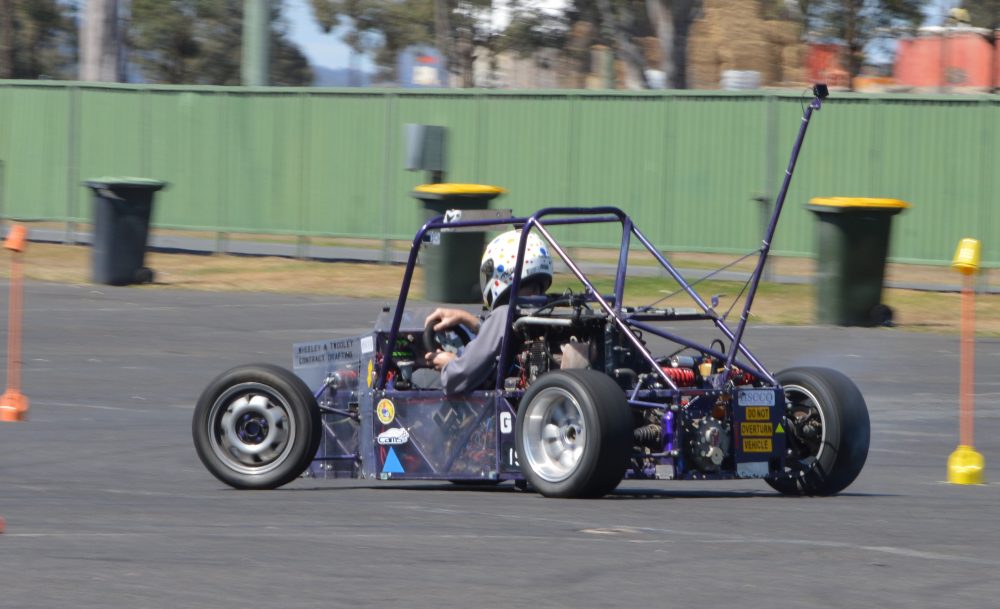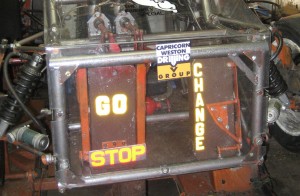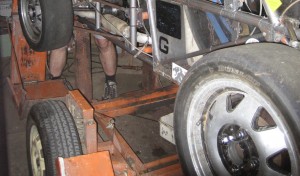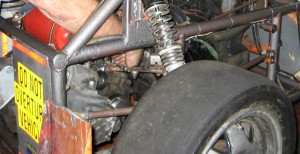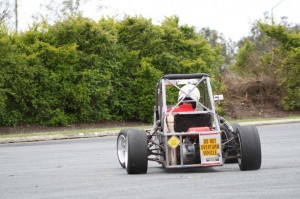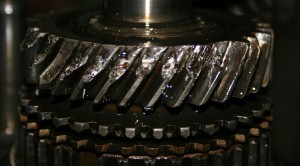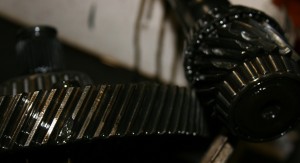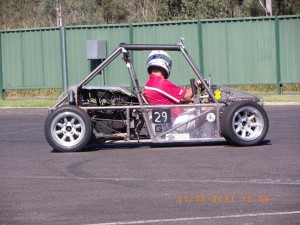CASPER, the Friendly Special.
This is the seventh motorkhana Special built by Alan Wheeley. Casper was the first of his specials that was completely designed by AutoCAD in a computer. The previous special, Gonzales, handled badly because of the lack of rear suspension, so this new car was designed with independant A Arm rear suspension, with an open differential so individual turning brakes could be used. Two VW Golf gearboxes were lying around, so one of them was designed into the car. The Z1000 Kawasaki bike motor out of the old car was tuned by a bike shop, and prepared for the new car. The internal gears of the VW gearbox were measured, and it was found that 4th gear would provide about 90 kilometres per hour at 11,000 rpm, and first gear in the bike box. Because third and fourth gears are side by side on the input shaft, and have synchromesh between them. it was decided to convert the third gear set into chain sprockets, wrap a chain around them, and have a reverse gear set with synchros between forward and reverse. The gears were very carefully measured, and drawings produced for the specialised manufacture of these components. Because of the size of the synchro rings, the sprockets would give a top speed in first gear of 97 kph.
In January 2002, many lengths of 38.1 OD x 1.6 mm wall 350 grade ERW Tube were purchased. On Sunday 3-2-2002 a start was made on fabricating the chassis frames. The upper and lower frames were welded up, but ran out of welding rods. On Wednesday 6-2-2002 the basic chassis was finished. Next day took the motor out of Gonzales, put it in position in Casper, and fabricated the engine mounts. 20-2-2002 got the cage pipes bent, and next day welded them up. On 23-2-02 welded the 1.6 mm Zincanneal floor pan on. 25-2-02 made and fitted firewall. Next day started the long slow process of fabricating and installing all the ancillaries like gear linkages, pedal mounts, dashboard, chain tensioners.
On 6-3-02 started on the rear suspension, by making the suspension mounting brackets, but found that the proposed De Dion Beam fouls on the arc of the kick starter. Experimented with upside down rear suspension, but discarded the idea. 8-3-02 returned to the A Arm wishbone design, and fabricated all the suspension arms in the following week. The front suspension was started on 15-3-02.
The footwell of the car was designed to take three pedals across the car. Then a different idea was thought of where the accelerator and brake pedal were combined into one pedal. Because even F1 drivers take 0.2 seconds to get off the accelerator and onto the brake, and then 0.2 seconds to get back onto the accelerator, meaning that even a F1 driver would spend 0.4 seconds at each pole neither accelerating nor braking. In the Multiple Loop Test, there are 11 instances of this being needed, resulting of at least 4.4 seconds being lost. So an aluminium accelerator pedal was built, and hinged at the bottom on a 25 SHS frame, which surrounds the pedal. A throttle cable end was anchored on the side of the pedal, and the sheath anchored on the frame, to make the accelerator work in relation to the frame. Then the whole frame was hinged at the top on the main chassis, with this frame pushing on the brake master cylinders through a balance bar. The Bowden Cable then was anchored to the chassis with an “S” bend in it to allow for the brake pedal movement. This means now that the driver’s right foot never has to leave the accelerator nor brake pedal.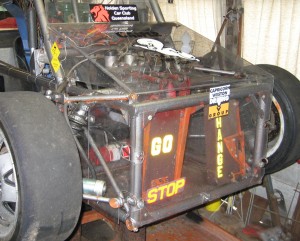
Work on the front suspension took another week to finish. Work on the rear suspension took another week. Four wheel steering is not allowed in Motorkhana Group 4H Regulations. It was banned many years ago. Because I was using VW Glof Mk 1 front hubs on the rear, I realised that there was a possibility of passively steering these rear wheels if the toe link connecting the steering arm was mounted on the chassis higher than on the upright. Then when the car rolled on its suspension in a turn, the outside wheel would turn outwards, and the inside wheel would turn inwards, with the result being a car that would automatically turn the rear wheels around poles. 6 millimetres difference in height was built into the mounting points. The photo below shows the rear wheel steering in action.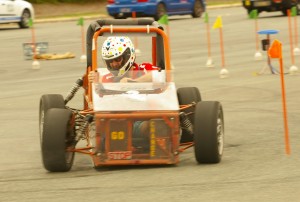
Another week was spent building and fitting all the brakes. Then another week for all the fuel systems. Then on 17-4-02 everything was taken off the chassis ready for painting, which took another week. Then the job of re-installing everything started. Along the way, I designed a lifting system into the trailer, consisting of two SHS frames hinged in the inside of the trailer, that normally sit flat with the chassis. The pivot point axles have 3/4″ chain sprockets on them with a chain wrapped around them. A Goggomobile jack was mounted so that when the nut was turned, the jack extends, and makes both the frames come up together under the car to raise it off the wheels, and leave it at a better height to work on.
38 ID x 13 wall Roll Bar Padding was glued onto the cage. Then the bodywork was started in clear acrylic. The car was then taken to the bike expert where it was tuned, new timing chain fitted, and new jets in the carbs. On 6-7-02 the firewall, seat, belts were installed, and the chain for the primary drive cut to length. A standard VW Golf gearbox was fitted to check all the alignments. New master cylinders were fitted on 17-7-02, but bleeding them was a problem because they were mounted on the floor, and the turning brakes high up. All the brake fluid kept running back into the master cylinders. A week later, and a rough wheel alignment performed so that the car could be driven for the first time on Saturday 3-8-02. The rear suspension bottomed out with a 100 kg load, so the suspension arms were relocated.
Sunday 24-8-2002 was its first competition at the MG Car Club Ironman event, where the motor did not run properly at low revs, the brakes were very bad, and the rear wheel steering was too violent. The steering ratio was not good, with too many turns needed to go from lock to lock. A week later, new brake balance bars were fabricated to try to solve the brakes, and the rear suspension bottoming was solved by the fittment of new spring/damper units. Sunday 8-9-2002 was the Queensland Motorkhana Championship Round 5 at Queensland Raceway where the brakes were still bad, the motor still ran poorly, and oil started leaking out of the tacho drive. Things were no better at Round 6 on 17-11-02, but at least the turning brakes were working well.
To solve the steering problem, a Go-Kart style system was built, and together with a new larger diameter steering wheel was tried out on 2-2-03. The steering shaft sheared from the pressure, so a design utilising a modified Renault 10 rack was started. To try to solve the motor problems, a new air box was made from a VW Golf unit. It was all tested out at Round 1 of the QMC on 23-3-03, but the fuel pump failed. New hotter spark plugs were tried, but it started backfiring and running very rich. Testing was halted by a broken C.V. Joint.
At this point it was decided to give up on the Kawasaki Z1000 motor, and get a younger replacement. On 8-4-04 a Kawasaki ZXR-750 was purchased for $1600. Six months later the change over was started. The motor mounts are different, so the old ones were cut off, and new ones fabricated. The exhaust pipe centres are different, so new pipes were manufactured using the old ones as a basis.
In January 2005, when the chain was being fitted, it was found that the newer motor has 5/8″ chain, so all new sprockets and chains have to be purchased. The new motor is water cooled, so a radiator position had to be finalised, and all the pipes connected up. on 12-2-05 all was ready for a test firing of the motor, but when the isolating switch was connected there was a giant spark in the electrics. A dead short in one of the terminals. Fixed that, and the engine started and ran, but the revs climbed after 10 seconds. An extra spring was put onto the throttle return cable, but no difference. Investigations showed that the choke cable was sticking, so an extra spring was fitted to it so solve the problem.
The first competition with the new motor was on 13-2-05 where the ride height was set too low, but the motor ran well. A new chain path was designed to better utilise the chain, and two teeth taken out of the chain to make it all work. The car was towed out to Roma for a demonstration motorkhana where it kept jumping out of gear on the over-run. When the gearbox was taken apart, it was found that the circlip was not fitted properly to the end of the input shaft, and the pressure on the gears made the shaft slide through the box. On the over-run, the movement caused it to jump out of gear.
New “Lexan” bodywork was fitted to the car just before towing it all the way to Perth for the AMC in 2005 where the chain adjuster came off halfway through the competition. With not enough time to solve the problem, it was loaded on the trailer for the 4,000 kilometre journey home.
A home made steering rack was manufactured for the car in February 2006, and a restrictor placed in the fuel return line. The brake balance bar was removed, and replaced with a simpler system. In June 2006, a reversing mirror was built, but the field of vision was not good enough to use in competition.
Just after the AMC of 2006 (held in Brisbane), an air operated forward/reverse system was manufactured using a pneumatic cylinder to change direction in the box, powered by a reservoir, and switched by a button on the right hand turning brake. The systen was tested on 8-11-06, and all worked well.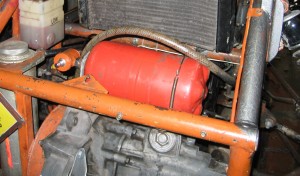
Early in 2007, a new smaller diameter steering wheel was built and tested OK. 2 degrees negative camber was built into the front suspension to better utilise the front tyres. In July 2007, new front spring/damper units off a Suzuki RGV250 were tried on the front, and the resultant firmer front suspension made a great improvement to the handling. The steering was still not good, so an “Edge” steering rack from a sand buggy was obtained. It was fitted in October, 2007 with another improvement in performance.
January 2008 saw a major rebuild, and a change of colour to Hammertone Charcoal. It was towed to Rockhampton for Round 1 of the QMC, but somehow water had got into the fuel tank, and it would not run properly. The first test was missed while trying to flush some fresh fuel and metho through the lines, and by the end of the day it started to run at over 6000 rpm again. Next day at Gladstone, it ran better again.
At a private test day on 5-5-08 all the corner weights were tested both with driver aboard and empty. Caster and camber gauge settings were checked and adjusted. A camera was set up to film the suspension at work, and the results analized. The next week, the old problem of jumping out of gear re-appeared, and it was found out that the circlip had come off the input shaft again because of the sideways pressure. The VW Gearbox is technically running backwards from the Golf design, so the shaft was taken out and washers fitted at the loaded end.
The clutch started playing up in November 2008, and it was found out that the standard Kawasaki clutch master cylinders are pressure bled when new, and so the position of the bleed hole is not important. This was only found out after buying replacement parts at great expense, and so a different type of clutch cylinder was fitted.
At the next motorkhana, the right rear suspension unit sheared off, so Kayaba suspension units were purchased to replace the originals. One sprung a leak, and had to be rebuilt. New 7″ x 13″ rims were fitted for the Wheels on Wide Bay event, but something broke in the gearbox. When the box was taken apart, there were broken teeth on both gears, half a tooth was broken off the diff gear, and the diff pinion severely damaged. The thrust washers had failed, and jammed the gear teeth.
The input shaft was then ground to suit a proper thrust bearing, and all re-assembled. It all worked well for the Iron Man Motorkhana where the car won outright. A new muffler replaced the hot dog unit to soften the harshness of the sound. The plastic coolant header tank was replaced by a metal one in 2011, after the plastic one melted.
Some American brand crossply slicks were tried out in September 2011, but because of the light weight of the car, they did not build up any temperature on the front, and subsequently did not grip well. All sorts of tyre pressures were tried with no better result. So a pair of Formula SAE front Hoosier tyres were purchased to put on the front wheels. Grip was suddenly improved. New lower front A arms were fabricated to get 30 millimetres of caster in the fronts to better utilise the tyres, but this caused a problem on full lock in reverse, where it became difficult to get the car straight again.
